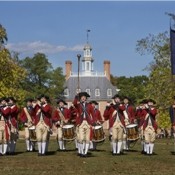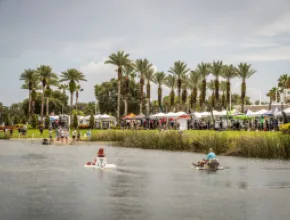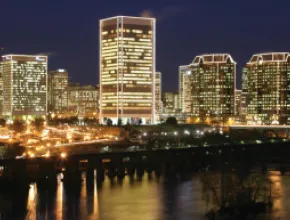Groups that gather in Virginia are never far from the state’s four centuries of history, much of which has national significance. Beginning with the 1607 founding of Jamestown, Virginia has a lot of early American stories to tell. It has more Civil War sites than any other state. Several American presidents, including George Washington and Thomas Jefferson, were Virginians, and their homes are on the state’s tour roster. One of the world’s largest history museums is Colonial Williamsburg.
According to Joni Johnson, national sales manager for Virginia Tourism, there are myriad ways groups may sample the heritage, and costumed interpreters can enliven the experience.
“History really comes alive at sites and museums all over the state when Virginians like George Washington and Thomas Jefferson interact with the group, courtesy of interpreters like Living History Associates,” Johnson says.
Northern Virginia
Sophisticated and business-ready, this urban region across the Potomac River from the nation’s capital is brimming with historical connections like Manassas National Battlefield Park and George Washington’s Mount Vernon estate.
Alexandria and Arlington lie along the river and offer groups upscale meetings hotels and after-hours diversions, along with the heritage.
Throughout Fairfax and Loudoun counties are contrasts to local 21st century cityscapes in the rolling pastoral scenery next to the Blue Ridge Mountains. Tours of local wineries are an enjoyable way to navigate the terrain.
“Being in the greater Washington, D.C., area gives groups that base themselves in Fairfax County access to a very large variety of heritage experiences and historical sites, everything from Mount Vernon to the National Mall, historic farms, Civil War battlefields, and African-American history sites,” says Sarah LaRose, director of communications for the Fairfax County Convention and Visitors Corporation. “Planners can find a lot of ideas on our website for incorporating regional history in their programs.”
National aviation history can be the backdrop for events of up to 5,000 guests at The Smithsonian’s National Air and Space Museum Steven F. Udvar-Hazy Center, located next to Washington Dulles International Airport. At the center, 200 aircraft and spacecraft and other historical memorabilia are on display.
The big band era is alive and well at Alexandria’s Carlyle Club, where ’40s-style Art Deco decor provides a unique dinner setting backed by big band entertainment. The site features props from the movie The Aviator to set the mood, and an upper-level private dining room with a one-way window overlooks the main level, featuring candlelit bistro-style tables and a stage.
Some of Alexandria’s three centuries of history is on display in the new Freedom House Museum. It was once headquarters for the largest and most successful domestic slave trading firm in America. It opened last February with a dedication to Rev. Lewis Henry Bailey, a former slave who had been “sold South” through that slave market but later returned to the area to found several schools and churches that still thrive today. Private group tours may be arranged.
The significance and suffering of the Civil War comes into focus during guided group tours at Northern Virginia’s battlefields. Two major battles occurred at Manassas National Battlefield Park in Prince William County, and Fredericksburg/Spotsylvania National Military Park showcasess four battlefields (Fredericksburg, Chancellorsville, The Wilderness, and Spotsylvania Court House) with audiovisual presentations and museum exhibits.
Central Virginia
Today, Richmond is Virginia’s capital, and it filled the same role for the Confederacy. Groups may study artifacts and exhibits about the Civil War in the Museum of the Confederacy, where several spaces accommodate groups of up to 150 for receptions and meals.
Other downtown historic sites include St. John’s Church, site of Patrick Henry’s “give me liberty” speech in 1775, and reenactments may be arranged for groups of up to 325 people.
The Virginia Historical Society is housed in Richmond’s Museum District, near the hip and historic Fan District. Visitors who travel this cultural corridor experience premier gardens, history, art galleries, interactive science and technology exhibits, special events, and more. The society offers meeting space as well as exhibits that focus on Virginia heritage, such as the current one on moonshining in the Blue Ridge.
Just south of Richmond is Pamplin Historical Park, the “ultimate” Civil War experience site. The 422-acre campus features four museums, three antebellum homes, costumed living history interpreters, original Civil War battlefield fortifications, and interactive experiences. A guide will escort groups not only through the park and museum, but also put them through a few paces (like marching) taken from a Civil War infantry manual.
Following a $2.1 million restoration, the Lynchburg Museum at the Old Court House has new exhibits and media programs that focus on events and people who have shaped Central Virginia and the “Hill City.” Included are furnishings made in Lynchburg, fine art, antique toys, Civil War memorabilia, and artifacts from the Civil Rights era.
Just west of Richmond is an area filled with the same rolling terrain and mountain vistas that captured the souls of early Americans. Jefferson’s Monticello estate is near Charlottesville, as is his learning legacy, the University of Virginia, where groups may enjoy customized tours.
Charlottesville’s historic property options include Prospect Hill, an authentic 18th century plantation consisting of a circa-1732 manor house. The property has 13 distinctive guest rooms with contemporary appointments. The facilities and peaceful 50-acre grounds at Prospect Hill also accommodate small conferences and receptions of up to 200 people.
Charlottesville’s history as a popular meetings destination since the Colonial era will gain new dimension this fall with the October opening of the Boar’s Head Inn Pavilion. At 9,000 square feet, it will bring the historic inn’s total square footage of meeting space to 22,000, elevating the city’s profile in the meetings market, according to Mark M. Shore, director and CEO of the Charlottesville/Albemarle CVB.
“Charlottesville has clearly become a destination of choice for meeting and event planners, but we have lost business opportunities by not having large enough facilities at a single site,” Shore says. “The addition of the meeting pavilion at Boar’s Head Inn is another crown jewel for our region.”
Tidewater and Hampton Roads
America established itself in the Historic Virginia Triangle region of Jamestown, Williamsburg and Yorktown. Four centuries of heritage now flow through 21st century waterfront communities and urban landscapes in the cities of Hampton, Norfolk, Newport News, Virginia Beach, Williamsburg, and Portsmouth.
Elizabeth Dyer, media and communications coordinator for the Virginia Beach CVB, says Virginia Beach and the entire region offer plenty of early American historic connections for groups to integrate into programs.
“We recently hosted the American Bus Association Marketplace for over 1,300 delegates, and we offered 15 different tours throughout the region, many with historic connections,” she says. “One was ‘Settlers—From Land to Sea,’ incorporating historic homes, lighthouses and the first Landing Cross at Cape Henry. That is where English settlers first landed in the New World in 1607 prior to developing Jamestown settlement.”
In Portsmouth, costumed guides lead groups through historic neighborhoods on the Olde Towne Lantern Tour, a walk through legends and lore and past vintage architecture. Portsmouth also has a new military museum containing an absorbing collection of military uniforms, weapons and memorabilia from all wars in which America has participated. Displays spotlight everyday life in military service in the 18th, 19th and 20th centuries.
“History is always on the agenda for meeting planners in Newport News,” says Cheryl Morales, group marketing manager for the Newport News Tourism Development Office. “Not only can we host icebreakers at several of our historic homes, we can also schedule specific programs about our history as part of an agenda or activity. Marines’ Museum/USS Monitor Center and the Virginia Living Museum are perfect locations to explore both Virginia and national history. We’ve even had [an interpreter dressed as] Christopher Newport, captain of the three-ship English fleet that landed at Jamestown in 1607, meet and mingle with attendees.”
Boykins Tavern Museum on the Isle of Wight was built by Major Francis Boykin, who camped with Washington at Valley Forge. Located beside the circa-1800 courthouse Boykin helped pay for, it is eight miles from downtown Smithfield and has two recently restored and historically decorated rooms that are suitable for meetings.
The Tidewater’s Route 5 Scenic Byway east of Richmond into Jamestown is replete with heritage stops that encompass the period from Jamestown’s beginnings and the introduction of the plantation economy to the Civil War and the end of slavery. The trail includes three National Park Service sites, landmark plantations, parks, and historic highway markets.
In Williamsburg, history is out in front. Dozens of reconstructed and restored buildings line Duke of Gloucester Street, which has been called the “most historic avenue in all America.” This restored 18th century Virginia treasure is one of the nation’s foremost historic sites, and it comes with top-drawer meetings-ready hotels. Whether a group attends a street performance of “Revolutionary City,” an interactive depiction of everyday life in the city as the Revolution became a reality, or a private tavern dinner, the 18th century provides the ambience.
Western Virginia
Fresh mountain air, verdant terrain and quaint towns greet the senses in the Shenandoah Valley along a 200-mile-long swath through the Blue Ridge and Allegheny mountains. Two hundred years ago, the valley drew Scotch, Irish and German farmers whose descendants still work the land.
Splendid autumn color and seasonal maple sugaring suggest New England. Revolutionary War and Civil War history defines the region as surely as do its state parks, rivers and forests. Natural attractions include the dramatic stalagmites and stalactites of Luray Caverns, as well as Natural Bridge, a National Historic Landmark once owned by Thomas Jefferson.
Historic mountain resorts and inns like The Homestead in Hot Springs and the newly refurbished Mimslyn Inn near Luray Caverns perpetuate the gracious hospitality and relaxing atmosphere amid nature that have lured guests to the Commonwealth’s western side for generations. The verandas, lawn areas, pavilion, and gazebo at historic Mountain Lake Hotel in Pembroke are just some of the venues groups use on property. The movie Dirty Dancing was filmed there, and some planners run the movie and theme their events to sync with that piece of pop cultural history.
Daniel Boone and other frontier settlers passed through these mountain vistas during the nation’s westward expansion in the 18th and 19th centuries, and the Museum of Frontier Culture in Staunton, the Settlers Museum of Southwest Virginia and over 100 sites along The Wilderness Road: Virginia’s Heritage Migration Route chronicle the rich heritage.
The Crooked Road: Virginia’s Heritage Music Trail leads visitors through historic music venues like the Carter Family Fold, which put people in contact with the roots of Appalachian music and its people.
Visitors to these highlands also enjoy clogging and square dancing events as after-business diversions, along with shopping for indigenous crafts like ladder-back chairs and quilts. At the oldest professional theater in the U.S., the Barter Theatre in Abingdon, spectators enjoy performances on the same stage that launched names like Ernest Borgnine, Gregory Peck, Hume Cronyn, and Patricia Neal.
For More Info
Abingdon CVB 276.676.2282 www.abingdon.com
Bristol CVB 423.989.4850 www.bristolchamber.org
Alexandria Convention and Visitors Association 703.838.4200 www.visitalexandriava.com
Arlington Convention and Visitors Service 703.228.0873 www.stayarlington.com
Charlottesville/Albemarle CVB 434.293.6789 www.pursuecharlottesville.com
Chesapeake Conventions and Tourism 757.502.4898 www.visitchesapeake.com
Fairfax County Convention and Visitors Corporation 703.790.0643 www.fxva.com
Fredericksburg Department of Tourism 540.373.1776 www.meetatfred.com
Greater Williamsburg Chamber and Tourism Alliance 757.229.6511 www.visitwilliamsburg.com
Hampton CVB 757.722.1222 www.hamptoncvb.com
Harrisonburg/Rockingham CVB 540.432.8935 www.harrisonburgtourism.com
Lexington/Rockbridge Area Visitor Center 540.463.3777 www.lexingtonvirginia.com
Lynchburg Regional CVB 434.845.5966 www.discoverlynchburg.org
Newport News Tourism Development Office 757.926.1400 www.newport-news.org
Norfolk CVB 757.664.6620 www.norfolkcvb.com
Portsmouth CVB 757.393.5327 www.visitportsva.com
Prince William County/ Manassas CVB 703.396.7130 www.visitpwc.com
Richmond Metropolitan CVB 804.782.2777 www.visit.richmond.com
Roanoke Valley CVB 540.342.6025 www.visitroanokeva.com
Suffolk Division of Tourism 757.923.3880 www.suffolk-fun.com
Virginia Beach CVB 757.385.4700 www.vbfun.com
Virginia Tourism Corporation 804.545.5500 www.virginia.org
Wytheville CVB 276.223.3355 www.visitwytheville.com






